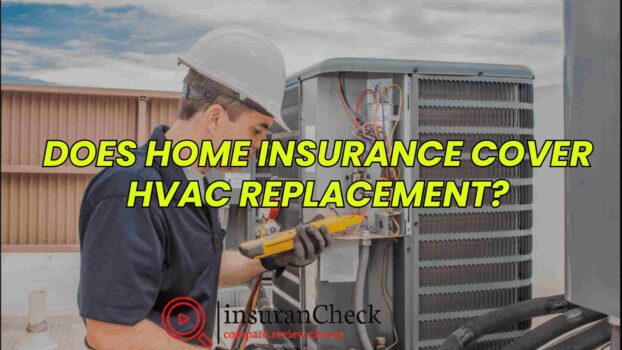Imagine your HVAC system fails on a scorching summer day or a bitterly cold winter night due to an electrical issue. Many homeowners then ask, “Does Home Insurance cover HVAC replacement?” Replacing an HVAC system is expensive. So, knowing your policy can prevent financial stress. Some plans cover HVAC damage from certain electrical problems. Others do not. This article explains how home insurance deals with these issues. It helps you understand your options and makes claims easier.
Best Home Insurance Providers
When Does Home Insurance Cover HVAC Replacement?
Homeowners need to know when their home insurance policy covers the cost of replacing their HVAC system, since repairs or replacements can be expensive. While home insurance typically doesn’t cover routine maintenance or wear and tear, there are specific circumstances where it might pay for HVAC replacement due to damage caused by covered events.
Coverage for Sudden and Accidental Damage
Home insurance usually covers HVAC replacement for sudden, accidental damage. For instance, if a fire, lightning, or a fallen tree damages your HVAC, insurance might cover it. These types of events fall under the “named perils” section of your policy, which covers specific risks outlined in the terms. Similarly, damage from a lightning-caused power surge may also be covered.
Damage Caused by Covered Perils
In some cases, your home insurance may cover the cost of replacing your HVAC system. For instance, this includes damage from storms, hail, or burst pipes. If a severe storm damages your HVAC unit, your policy could help. This applies if damage is due to flooding or debris. Ensure the damage cause is on the list of covered perils.
Exclusions and Limitations
Home insurance policies exclude coverage for normal wear and tear, neglect, and lack of maintenance. If your HVAC fails due to age or lack of care, insurance likely won’t help. The same applies to mechanical failures from poor maintenance or aging.
Maximizing Coverage
To protect your HVAC system, consider equipment breakdown coverage or a home warranty. These options cover failures not in standard home insurance. They ease worries about unexpected problems. Also, regular maintenance and documentation keep your system ready for claims.
When Doesn’t Homeowners Insurance Cover HVAC Replacement?
Homeowners insurance often covers HVAC replacement, but not always. Some situations lead to exclusions. Knowing these is key. It helps you avoid surprises and prepares you for unexpected expenses. Here are the main situations where your coverage falls short.
Wear and Tear or Age-Related Damage
One of the most common things not covered by homeowners insurance is damage from normal wear and tear or systems simply getting old. HVAC units, like all appliances, have a limited lifespan. Even if your system malfunctions, insurance usually won’t pay for a replacement once its useful life is finished. Simply wearing out is a maintenance issue, not an insurable event.
Neglect or Lack of Maintenance
If your HVAC system breaks down because you didn’t take care of it, your homeowners insurance won’t pay for a new one. Insurance policies usually don’t cover damage caused by poor maintenance, like dirty filters, clogged ducts, or missed servicing appointments. Regular maintenance is a must to make your HVAC system last. If you don’t take action, you may have to pay for repairs yourself.
Mechanical Failures or System Malfunctions
Home insurance excludes mechanical breakdowns not linked to covered events like fire or storm. For instance, if your HVAC system fails due to a broken compressor or faulty parts, it typically won’t cover repairs or replacement.
Damage Caused by Improper Installation or DIY Repairs
If damage comes from bad installation or DIY fixes, your home insurance might not cover it. For instance, if a licensed pro didn’t install your HVAC system, or if your repairs caused more damage, the insurer could deny your claim. So, always have a licensed technician handle your HVAC system to avoid these issues.
How to File a Claim for HVAC Damage
Filing a claim for HVAC damage is a straightforward process if you follow the right steps. Understanding the process ensures smooth handling and fair compensation.
1. Document the Damage
To start the process of filing an HVAC damage claim, thoroughly document the damage. Take clear photos or videos of the unit, focusing on the damaged areas. Also, if you can, record factors that might have contributed to the damage, like storm impacts or debris. This documentation is essential for when you submit a claim to your insurance provider.
2. Contact Your Insurance Company
First, document the damage. Then, contact your home insurance company. Call them or use their online portal to report the incident. Explain the cause of the damage, providing any evidence you’ve gathered. Some insurers might send an adjuster for the HVAC unit. Others may request an independent assessment.
3. Get an HVAC Professional’s Evaluation
Often, your insurance company will need a certified HVAC technician to evaluate the damage. The technician will assess the damage, identify its cause, and estimate repair or replacement costs. This report is vital. It determines if your policy covers the damage and what compensation you can expect.
4. Submit Your Claim and Follow Up
After gathering all documents and evaluations, submit your claim with the needed paperwork. Always keep copies of receipts, inspection reports, and talks with your insurer. Then, regularly check in with your insurance provider about your claim’s status. They might need more information or clarification, so staying in touch helps avoid delays.
Act Now
If your HVAC system is damaged, don’t delay – take action right away. First, take clear photos and videos to document the damage, then reach out to your insurance provider to report what happened. Have a professional HVAC technician assess the system, as their report is crucial for your claim. Then, review your insurance policy to understand what is covered and what is excluded. Submit your claim quickly. Keep all receipts and records of communication. Start soon. Your system can then be repaired or replaced faster, avoiding costly delays. Take action today to ensure coverage.










